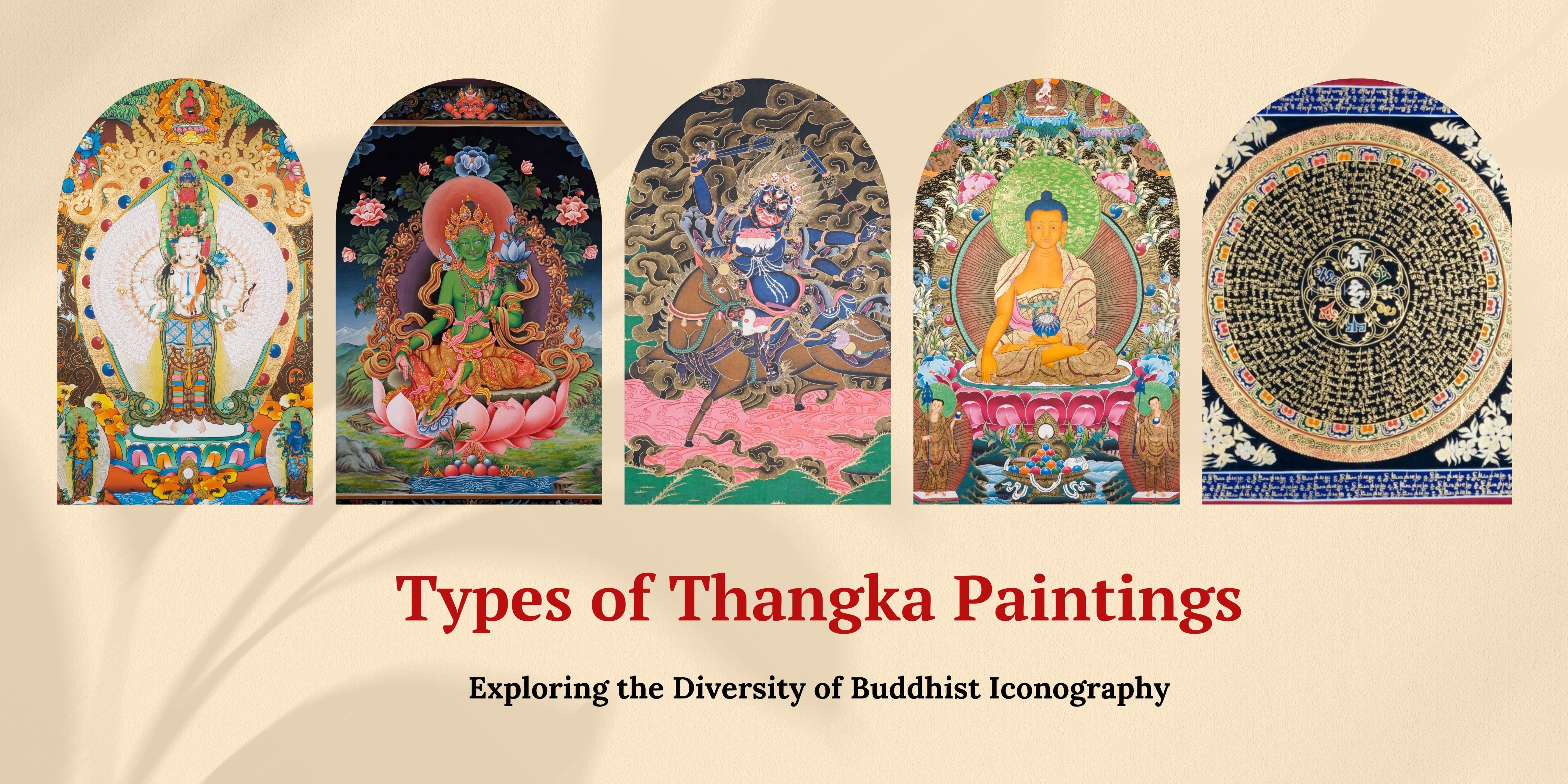
Types of Thangka Painting: Discover the Spiritual and Artistic Beauty of Buddhist Iconography
Thangka painting, a form of Tibetan Buddhist art, stands as a tribute to the rich cultural heritage of the Himalayan region. From depicting peaceful deities to intricate mandalas, Thangkas are not just artworks but sacred symbols filled with spiritual significance. In this blog, we delve into the diverse types and styles of Thangka painting, shedding light on their uniqueness and cultural importance.
Peaceful Deity:
Peaceful deity Thangkas exude serenity and tranquility, offering a visual representation of compassion and enlightenment. These paintings often feature revered figures like Buddha or Bodhisattvas, depicted with gentle expressions and serene postures. Through intricate details and vibrant colors, they evoke a sense of inner peace and spiritual harmony, guiding practitioners towards a state of meditation and enlightenment.

Wrathful Deity:
Wrathful deity Thangkas embody the fierce aspects of the divine. These paintings depict deities like Vajrapani or Mahakala, adorned with wrathful expressions and dynamic poses. Symbolizing the power to overcome obstacles and destroy ignorance, wrathful deity Thangkas serve as protective forces, warding off negative energies and obstacles on the spiritual path. Their vivid imagery and intense symbolism inspire practitioners to confront and overcome inner and outer challenges.

Mandala:
Mandala Thangkas are intricate geometric patterns symbolizing the universe and its cosmic energies. These sacred diagrams often feature a central deity surrounded by concentric circles, squares, and intricate symbols. Mandalas serve as tools for meditation and spiritual transformation, representing the journey towards enlightenment and the interconnectedness of all beings. Through their meticulous design and symbolic representation, mandala Thangkas invite practitioners to explore the depths of their consciousness and connect with the divine.

Other Iconography:
Beyond deities and mandalas, Thangka paintings encompass a myriad of other iconographies, including scenes from Buddhist scriptures, religious narratives, and symbolic motifs. These paintings convey profound teachings and philosophical concepts, offering visual narratives that inspire devotion and contemplation. From depicting scenes of enlightenment to illustrating the stages of the Buddhist path, other iconography Thangkas serve as visual guides for practitioners on their spiritual journey, enriching their understanding of Buddhist teachings.

Exploring the Rich Diversity of Thangka Painting Styles
Thangka painting, with its intricate details and vibrant colors, has long been revered as a sacred art form in Tibetan and Himalayan cultures. Throughout history, various styles have emerged, each bearing unique characteristics and cultural influences. In this blog, we delve into four prominent styles of Thangka painting: Tibetan, Newari, Karma Gadri, and Contemporary.
Tibetan Style: Preserving Tradition with Symbolism
The Tibetan style of Thangka painting is deeply rooted in Buddhist iconography and religious symbolism. Artists meticulously adhere to traditional techniques passed down through generations, using mineral pigments and gold leaf to create intricate designs. These paintings often depict deities, mandalas, and scenes from Buddhist scriptures, serving as visual aids for meditation and spiritual practice. The rich symbolism embedded within Tibetan Thangkas conveys profound spiritual teachings, making them revered artifacts in Tibetan Buddhism.
Newari Style: Fusion of Artistry and Ritual
Originating in the Kathmandu Valley of Nepal, the Newari style of Thangka painting reflects a blend of indigenous Nepali aesthetics and Tantric Buddhist symbolism. Newari artists are renowned for their mastery of intricate details and exquisite craftsmanship, often incorporating elements of Nepali architecture and culture into their compositions. Thangkas produced in the Newari style are revered not only as religious artifacts but also as expressions of artistic excellence, often adorned with elaborate brocade borders and intricate patterns.

Karma Gadri Style: Harmony in Composition and Color
A distinctive feature of Tsurphu monastery is the Karma Gadri Thangka, a classic work of Tibetan Buddhist art. The 4th Karmapa established the Karma Kagyu innovation, the Thangka, sometimes referred to as the "Ornament of the World," in the 14th century. The Thangka is a religious image made by sewing together thick satins, silks, and brocades in an applied or "patch work" technique. Renowned for their ornate tent communities, the Karmapas journeyed across Tibet in enormous tent residences to convey Buddhist teachings to isolated areas. Completed in 1994, the Karma Gadri Thangka is a yearly exhibit at Tsurphu monastery and a tribute to the painting technique of the Karmapa lineage. The ceremony, which is an important religious occasion in Tibetan Buddhism, consists of formal ceremonial offerings, prayers, and devotional offerings to the Thangka.
Karma Gadri style emphasizes precision and balance in depicting religious figures and narrative scenes. Karma Gadri Thangkas are known for their serene beauty and delicate brushwork, embodying the spiritual principles of tranquility and enlightenment.

Contemporary Style: Evolution and Innovation
In recent years, Thangka painting has undergone a renaissance, with artists around the world experimenting with new techniques and interpretations while staying true to its spiritual essence. Contemporary Thangkas often feature modern themes, abstract motifs, and unconventional materials, reflecting the evolving tastes and perspectives of both artists and patrons. While some purists may view these innovations with skepticism, contemporary Thangka painting serves as a testament to the enduring relevance and adaptability of this ancient art form in the modern world.
Celebrating Diversity in Thangka Painting
Thangka paintings are a significant part of Tibet's spiritual heritage, showcasing profound teachings and wisdom. These paintings, depicting peaceful deities, wrathful beings, mandalas, and other iconographies, serve as sacred gateways to spirituality, encouraging practitioners to embark on self-discovery and enlightenment. The essence of Tibetan Buddhism continues to inspire and uplift souls worldwide. The traditions of Tibetan and Newari styles, as well as the refined elegance of Karma Gadri, continue to captivate audiences with their beauty and spiritual significance. Each style carries a unique legacy, preserving centuries of cultural heritage and inspiring new artists to push the boundaries of creativity.


